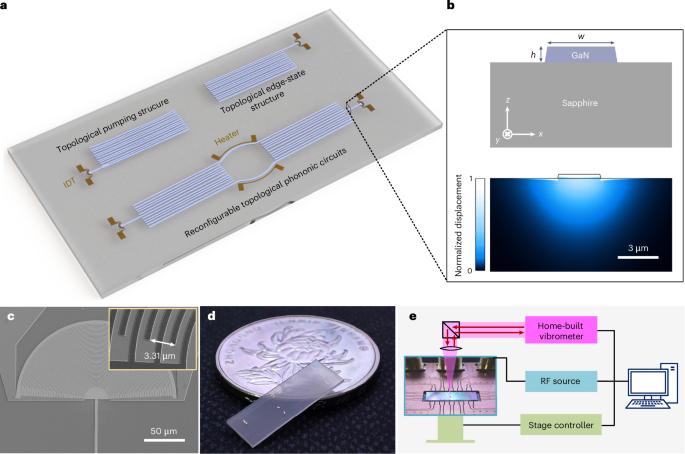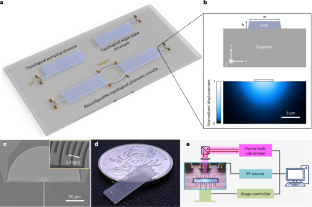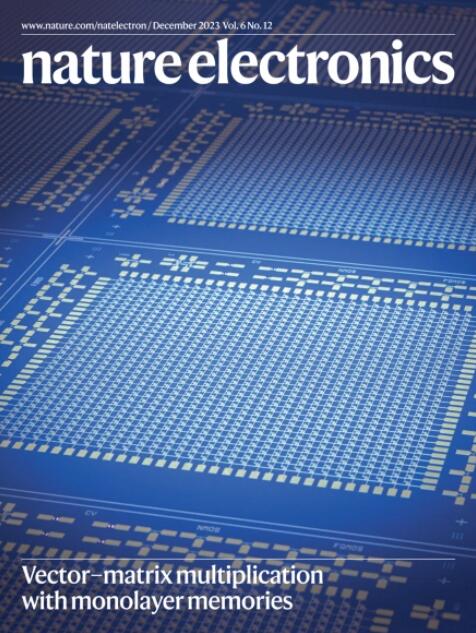基于微米尺度无悬浮波导阵列的千兆赫拓扑声子电路
IF 40.9
1区 工程技术
Q1 ENGINEERING, ELECTRICAL & ELECTRONIC
引用次数: 0
摘要
对千兆赫频率声波的操纵在经典和量子应用中都有应用。拓扑声学可以提供强大的声学控制,但实际应用通常限于低频或缺乏可扩展性。在这里,我们报告了工作在1.5 GHz的可重构拓扑声子电路。该方法基于微米尺度的无悬浮波导,该波导紧密地限制了声波。我们使用定制的高分辨率扫描光学振动计。我们对拓扑边缘状态和鲁棒索利斯抽运的空间演化的可视化与我们的理论分析是一致的。我们还开发了一种拓扑声子Mach-Zehnder干涉仪,该干涉仪可以快速切换拓扑声子传输路径,提供3db带宽为0.65 kHz的声强调制。我们的工作提供了一个可重构,紧凑和可扩展的拓扑声子芯片,工作在微波频率。本文章由计算机程序翻译,如有差异,请以英文原文为准。


Gigahertz topological phononic circuits based on micrometre-scale unsuspended waveguide arrays
The manipulation of gigahertz-frequency acoustic waves is of use in both classical and quantum applications. Topological phononics can provide robust acoustic control, but practical implementations are typically limited to low frequencies or lack scalability. Here we report reconfigurable topological phononic circuits that operate at 1.5 GHz. The approach is based on micrometre-scale unsuspended waveguides that tightly confine the acoustic waves. We use a custom-built high-resolution scanning optical vibrometer. Our visualization of the spatial evolution of topological edge states and robust Thouless pumping is in agreement with our theoretical analysis. We also develop a topological phononic Mach–Zehnder interferometer that can rapidly switch topological phonon transmission paths to provide acoustic intensity modulation with a 3 dB bandwidth of 0.65 kHz. Our work provides a reconfigurable, compact and scalable topological phononic chip that works at microwave frequencies. Reconfigurable topological phononic circuits that are based on micrometre-scale unsuspended waveguides and operate at 1.5 GHz can be used to create a topological phononic Mach–Zehnder interferometer that rapidly switches topological phonon transmission paths.
求助全文
通过发布文献求助,成功后即可免费获取论文全文。
去求助
来源期刊

Nature Electronics
Engineering-Electrical and Electronic Engineering
CiteScore
47.50
自引率
2.30%
发文量
159
期刊介绍:
Nature Electronics is a comprehensive journal that publishes both fundamental and applied research in the field of electronics. It encompasses a wide range of topics, including the study of new phenomena and devices, the design and construction of electronic circuits, and the practical applications of electronics. In addition, the journal explores the commercial and industrial aspects of electronics research.
The primary focus of Nature Electronics is on the development of technology and its potential impact on society. The journal incorporates the contributions of scientists, engineers, and industry professionals, offering a platform for their research findings. Moreover, Nature Electronics provides insightful commentary, thorough reviews, and analysis of the key issues that shape the field, as well as the technologies that are reshaping society.
Like all journals within the prestigious Nature brand, Nature Electronics upholds the highest standards of quality. It maintains a dedicated team of professional editors and follows a fair and rigorous peer-review process. The journal also ensures impeccable copy-editing and production, enabling swift publication. Additionally, Nature Electronics prides itself on its editorial independence, ensuring unbiased and impartial reporting.
In summary, Nature Electronics is a leading journal that publishes cutting-edge research in electronics. With its multidisciplinary approach and commitment to excellence, the journal serves as a valuable resource for scientists, engineers, and industry professionals seeking to stay at the forefront of advancements in the field.
 求助内容:
求助内容: 应助结果提醒方式:
应助结果提醒方式:


